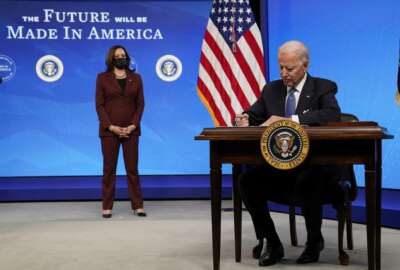Just how well do agencies alert contractors to their fiscal year buying plans?
The Professional Services Council, which represents hundreds of IT contractors, is out with its annual business forecast scorecard. Federal Drive with Tom Temin...
Best listening experience is on Chrome, Firefox or Safari. Subscribe to Federal Drive’s daily audio interviews on Apple Podcasts or PodcastOne.
Agency procurement and IT officials often remark about how closely they work with industry. But agencies vary a lot in how effectively they forecast their needs to industry, so contractors can best position themselves to meet those needs. The Professional Services Council, which represents hundreds of IT contractors, is out with its annual business forecast scorecard. Federal Drive with Tom Temin discussed with the PSC’s executive vice president for policy, Stephanie Kostro.
Interview transcript:
Tom Temin: Stephanie, good to have you back.
Stephanie Kostro: Thanks for having me Tom.
Tom Temin: And these scorecards, then do what what do they exactly tell us and how did you get the information?
Stephanie Kostro: We at the Professional Services Council, this is an annual cycle, this is the third iteration of our business forecast scorecard. And basically, we’ve looked at 69 different US federal agencies, and they’re publicly available websites. And we have 15 different attributes, and we go down the list and see if these publicly available websites provide the information that contractors need in order to do their business planning and be successful.
Tom Temin: And you had one agency get a perfect score.
Stephanie Kostro: This is the first ever time this has happened. And we are thrilled to say the US Agency for International Development has received a perfect score for 2021. The things that we’ve been looking for are changes that they’ve made. For example, they’ve now introduced a change log where contractors can see which which changes were made to the forecast and how it’ll shake out at the end of the day. So at the end of the day, contractors are thrilled with USAID’s website, and it is an example for other agencies to follow.
Tom Temin: And the honorable mention went to the Defense Health Agency and to the Department of Homeland Security, two got honorable mentions.
Stephanie Kostro: The Defense Health Agency, or DHA, had a challenging year for their forecast in 2020 and they’ve made great strides. So we were happy to give them an honorable mention for the most improved for 2021. And DHS has introduced something called their acquisition planning forecast system portal, some improvements to that portal, which have really made it a lot easier for services contractors to do their business planning when they’re looking at their DHS customer
Tom Temin: Got it. And some of them did not do so well. You’ve got rated, as you say 69 individual agencies, the bottom of the list, you’ve got places like the Marine Corps Systems Command, the Navy Supply Systems Command, the Defense Logistics Agency, which would be an unusual one to be that low. What do they not do very well, those particular types of agencies, to get a low score?
Stephanie Kostro: So for some of these agencies, they’ve taken their forecasts offline, so we can’t rate them if we can’t find their forecast. And so the agencies may turn around and say, hey it’s there if you looked for it, we did look for it. If it’s not there, we can’t rate it, and therefore they do get marked in red. And I come from a DoD background and it’s a stoplight. Right. And you never want to be red. And so it’s notable that these agencies have taken their forecasts offline, and therefore very little utility for for services contractors.
Tom Temin: So the orange or the red, I guess, on the way it renders, no forecast found or they didn’t score. And let’s get back to the good agencies, the Navy Information Warfare Systems Command ranked very highly consistently over the three years, the Center for Medicaid and Medicare Services, Education Department, there’s a lot of agencies across the board, TSA, that do really well. And what can contractors if they go to those sites learn from the ones that are really good at forecasting?
Stephanie Kostro: Contractors look at a range of information when they’re making their business decisions, the forecast is just one. And so what PSC has done is looked at the publicly available information, things like do they have a point of contact email, not just a common email address where everyone knows it’s sort of a black hole, but there’s an actual individual associated with the opportunity. They list the acceptable NIC codes, they list the incumbent, they list the award period of performance. It’s basic information that companies need in order to plan for their businesses, what they’re going to put in solutions or offers for and what they might skip. I will say DHS across the board has done fairly well on our 2021 scorecard, as you mentioned, a couple of their agencies like Customs and Border Protection, Coast Guard, FEMA, FLET-C which is the Federal Law Enforcement Training Center – They’ve all done very well for 2021.
Tom Temin: Excellent list. Take a look again out today, we’ll have a link to it. We’re speaking with Stephanie Kostro, executive vice president for policy at the Professional Services Council. And I wanted to ask you about the ongoing situation in Afghanistan, where certain types of contractors feel like they’re really in danger. And DoD is shifting its policy basically, because it’s not going to have presence but try to project over the horizon as they put it – what do contractors see ahead there?
Stephanie Kostro: Back in May when President Biden made his announcement that we were ending military operations and withdrawing US troops from Afghanistan, we joined two other associations in writing a letter to Secretary of Defense Austin, Secretary of State Blinken and USAID administrator Ambassador Power asking for coordinating efforts with contractors at that point there were tens of thousands of US contractors, many of which were US citizens in country, going what do we do going forward? Unfortunately, the executive branch officials did not get back to the three associations that wrote them that letter on May 13. And they’ve proceeded a pace with renegotiating some contract terms, providing the contractors with the mandate to do over the horizon contract support. And what does that mean? It means that contractors are relocating outside of Afghanistan in order to support Afghan national forces. On the DoD side, that will be the Afghan national security and defence forces, with things like maintenance over Zoom, over the phone, if stuff needs heavy maintenance, if aircraft, for example, needs heavy maintenance, it will depart Afghanistan and get that heavy maintenance outside of that country. It makes life very difficult for contractors. In addition, if we do we need to send contractors back into Afghanistan, the security situation is getting worse. We are still holding out hope that the executive branch will answer our inquiry and prove amenable to working with associations and contractors on this. But it’s been a couple of months with radio silence – and we are disappointed in that,
Tom Temin: Yeah, and there’s real physical danger to people there. It’s not just a business issue.
Stephanie Kostro: It’s a physical danger issue for not only the contractors, but also the the Afghans that they’re training. And the other issue that we’ve seen a lot of headlines talk about is the Special Immigrant Visa issue, which is there are linguists, aircraft maintainers, vehicle maintainers, folks that have worked with US contractors and US military forces for going on 20 years now. And what does their future look like in Afghanistan, many of them are trying to leave Afghanistan, seeking asylum for themselves and their families in the United States or elsewhere. And contractors are not getting a lot of information about what to do with the folks that they have working on contracts. Afghan officials or Afghan citizens who are working for these contractors want to get out and the contractors don’t have clear guidance of how they can support their contractors or employees in that case.
Tom Temin: All right. And while we have you I wanted to just ask about CIO-SP4 from NITAAC, is it salvageable at this point now that they have kind of have to redo their solicitation? It’s not even an award protest.
Stephanie Kostro: Yeah, it’s it’s a it’s a messy situation with the CIO-SP4 opportunity. For those of your listeners who aren’t familiar with it, it’s a $50 billion opportunity for 10 years. CIO-SP3 was about 20 billion. So this is significant growth in the CIO-SP4 basic information technology, support for health services and the like. We saw the RFP final version come out on May 25th. There have been several amendments in quick succession. I believe the dates were June 22, June 24, July 2 – it’s a fast moving amendment process here. And it’s really leading to anxiety and concern among the contractors who are trying to put together winning bids. The latest amendment, and I say that not knowing if an amendments coming out today, but the latest amendment extended the deadline to July 23, which is still not enough time for offers to put together offers that are fully cognizant of what the amendments in the final RFP say, so there are those who would just prefer that NITAAC rescind this RFP, answer all of the questions and resubmit it for for proposals. I’m not sure if NITAAC is open to that, but it is definitely an option that should be considered.
Tom Temin: I’d hate to be them now. Stephanie Kostro is executive vice president for policy at the Professional Services Council. Thanks so much.
Stephanie Kostro: Thanks Tom for having me.
Copyright © 2024 Federal News Network. All rights reserved. This website is not intended for users located within the European Economic Area.
Tom Temin is host of the Federal Drive and has been providing insight on federal technology and management issues for more than 30 years.
Follow @tteminWFED






